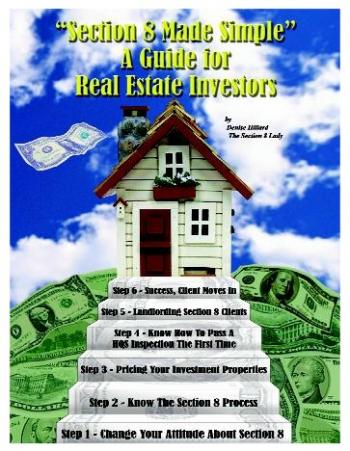BUILT explores the changing city in the US and the challenges that will affect housing, infrastructure, neighborhood cohesion, and equity in the coming years. BUILT is a series of research, installation, dialogue, interview, and performance events of varied scale, including the opportunity for public conversation offered at this blog.
This week’s post focuses on the cover of a book by a firm in Texas:
From inside the cover:
“The Section 8 program is a truly public-private relationship that serves the needs of low-income families by providing safe, quality housing opportunities using public funds for financial assistance. Public Housing Authorities (PHAs) manage the Section 8 program within specific geographic areas, and they represent the public side of the public-private relationship. The private side of the relationship is made up of real estate investors who profit by making their investment properties available to the Section 8 program.
As you will see, savy real estate investors reap many benefits from the Section 8 program that others who invest in real estate miss completely. This includes on-time rent collection, long-term tenants, shorter vacancy times, and at market or above market rents. But investors who participate in the Section 8 program get an added benefit that doesn’t relate to the bottom line – they are helping to serve the public interests by providing housing to those less fortunate.
Given all these benefits, the natural question that comes to mind is “Why don’t all real estate investors participate in Section 8?” Why indeed.
Once a new investor said to me, “I can do what you do and save money.” I said, “Exactly! I want you to be able to do what I do. That way, more Section 8 clients will have a decent place to live. However”, I also told him, “if you ever find yourself in legal trouble would you represent yourself, or have an attorney represent you? And if you chose to represent yourself, do you know how to properly defend yourself?”
If you are serious about your investments I would urge you to seek professional representation to ensure you are getting the most out of your investment and to reduce the time that you must invest in each property.
Having said that, this book will give you some tips on how to not only defend yourself, but will show you how to work within the Section 8 program to save you time and a lot of frustration.
Buy the book – Learn the process – Make a difference for yourself and your community!
$24.95
One might ask, What exactly is this book selling? How is it selling it?
BUILT is a performance/civic dialogue project and a collaboration of Northwesten University’s Theater Department & Portland, Oregon’s Sojourn Theatre, led by visiting artist Michael Rohd.

Nice writing. You are on my RSS reader now so I can read more from you down the road.
Allen Taylor
really big stairs to a tiny tiny house?
My first response to this book is that it is selling other peoples’ misfortune as an investment opportunity. Despicable. But my second response was rather different. We’ve already had a picture about gentrification and discussed the problems of displacement surrounding it, but what exactly causes gentrification? The market-driven, competition for wealth. This competition rarely if ever finds low-income housing to be lucrative. Poor people don’t have money, so who’s going to do business with them? Maybe this book is actually a long-needed remedy to my previous sentence. What if the proletarian masses was actually seen as an asset to personal investing, not a liability? Maybe the idea is not so despicable after all.
I am more confused than anything. the picture is cartoon-like. we’re talking about real estate and section 8. and there is so much money – and each bill is so very large…
the image is very striking – almost as if it’s a children’s book, about a very complicated issue. i suppose that’s his point.
i don’t really understand what he’s selling the book to do…. what process is he describing?
One thing this photo makes me think about, thematically, is where the social/human aspects of these questions bump up against the economic ones. In many of our stories and discussions deal mostly with human needs and wants and desires conflicting, and while economics and monetary concerns drive a lot of these, and may be at the heart of them all somehow, we don’t usually frame them that way. What is so striking about this photo is that Section 8 housing (like slums, or gentrification, or many other things), which can have what we view as terrible human consequences, can also be great (wise or lucrative) investments for other humans. I’m not saying this is a positive thing, but we do live in a capitalist country, and one thing that this photo illustrates is that from a capitalistic and non-humane point of view, section 8 housing is definitely a good thing (for the people who would purchase this book). The human cost (if it exists) is completely removed from the equation, something we as a group in the room never ever do. I’m not saying we should, but it is interesting as an exercise if nothing else to think that way, and we have to acknowledge that there are people out there who do.